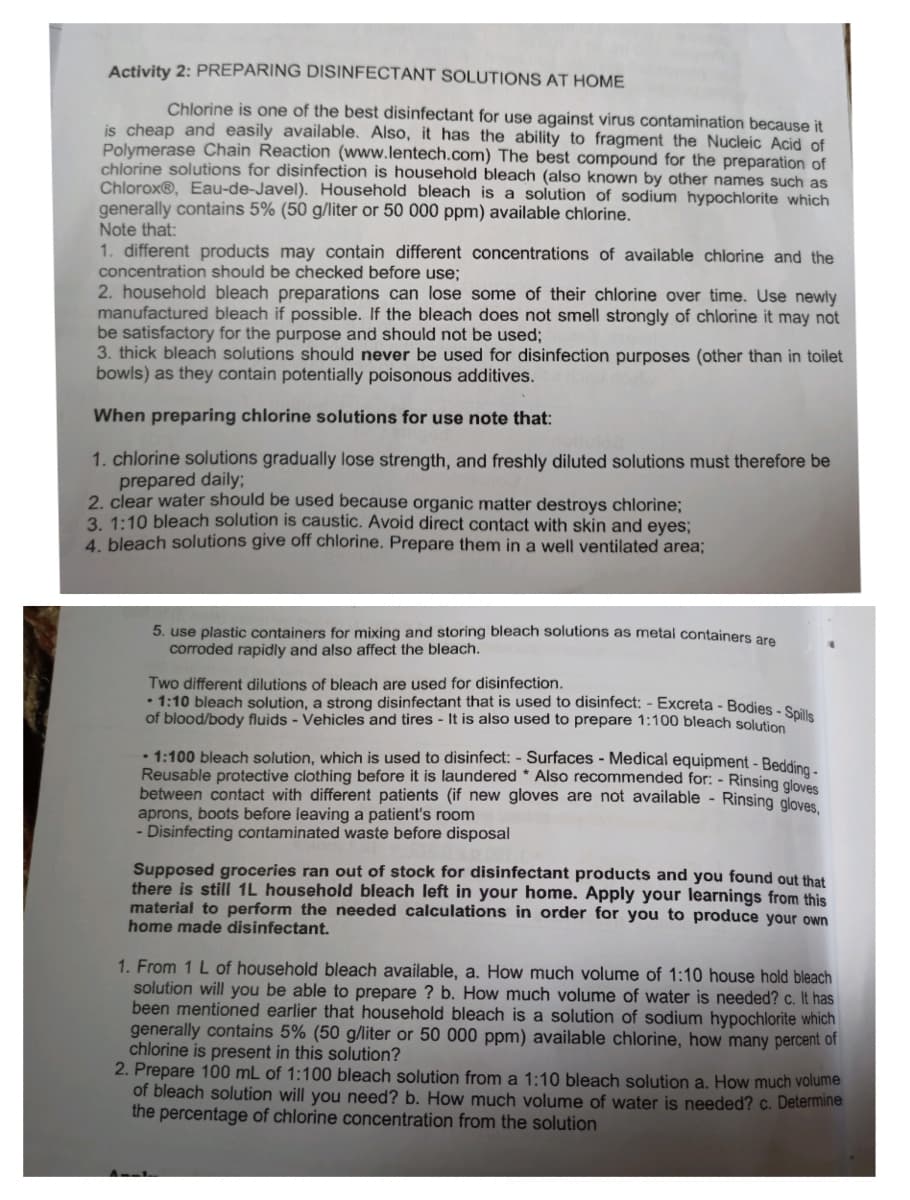Prepare 100 ml of 1:100 bleach solution from a 1:10 bleach solution a. How much volume of bleach solution will you need? b. How much volume of water is needed? c. Determine the percentage of chlorine concentration from the solution
Prepare 100 ml of 1:100 bleach solution from a 1:10 bleach solution a. How much volume of bleach solution will you need? b. How much volume of water is needed? c. Determine the percentage of chlorine concentration from the solution
Organic Chemistry
8th Edition
ISBN:9781305580350
Author:William H. Brown, Brent L. Iverson, Eric Anslyn, Christopher S. Foote
Publisher:William H. Brown, Brent L. Iverson, Eric Anslyn, Christopher S. Foote
Chapter28: Nucleic Acids
Section: Chapter Questions
Problem 28.7P
Related questions
Question
Prepare 100 ml of 1:100 bleach solution from a 1:10 bleach solution a. How much volume of bleach solution will you need? b. How much volume of water is needed? c. Determine the percentage of chlorine concentration from the solution
Note: show all solutions

Transcribed Image Text:Activity 2: PREPARING DISINFECTANT SOLUTIONS AT HOME
Chlorine is one of the best disinfectant for use against virus contamination because it
is cheap and easily available. Also, it has the ability to fragment the Nucleic Acid of
Polymerase Chain Reaction (www.lentech.com) The best compound for the preparation of
chlorine solutions for disinfection is household bleach (also known by other names such as
Chlorox®, Eau-de-Javel). Household bleach is a solution of sodium hypochlorite which
generally contains 5% (50 g/liter or 50 000 ppm) available chlorine.
Note that:
1. different products may contain different concentrations of available chlorine and the
concentration should be checked before use;
2. household bleach preparations can lose some of their chlorine over time. Use newly
manufactured bleach if possible. If the bleach does not smell strongly of chlorine it may not
be satisfactory for the purpose and should not be used;
3. thick bleach solutions should never be used for disinfection purposes (other than in toilet
bowls) as they contain potentially poisonous additives.
When preparing chlorine solutions for use note that:
1. chlorine solutions gradually lose strength, and freshly diluted solutions must therefore be
prepared daily;
2. clear water should be used because organic matter destroys chlorine;
3. 1:10 bleach solution is caustic. Avoid direct contact with skin and eyes;
4. bleach solutions give off chlorine. Prepare them in a well ventilated area;
5. use plastic containers for mixing and storing bleach solutions as metal containers are
corroded rapidly and also affect the bleach.
Two different dilutions of bleach are used for disinfection.
• 1:10 bleach solution, a strong disinfectant that is used to disinfect: - Excreta - Bodies - Seit
of blood/body fluids - Vehicles and tires - It is also used to prepare 1:100 bleach solution
• 1:100 bleach solution, which is used to disinfect: - Surfaces - Medical equipment - Beddie
Reusable protective clothing before it is laundered * Also recommended for: - Rinsing glovee
between contact with different patients (if new gloves are not available - Rinsing aloves
aprons, boots before leaving a patient's room
- Disinfecting contaminated waste before disposal
Supposed groceries ran out of stock for disinfectant products and you found out that
there is still 1L household bleach left in your home. Apply your learnings from this
material to perform the needed calculations in order for you to produce your own
home made disinfectant.
1. From 1 L of household bleach available, a. How much volume of 1:10 house hold bleach
solution will you be able to prepare ? b. How much volume of water is needed? c. It has
been mentioned earlier that household bleach is a solution of sodium hypochlorite which
generally contains 5% (50 g/liter or 50 000 ppm) available chlorine, how many percent of
chlorine is present in this solution?
2. Prepare 100 mL of 1:100 bleach solution from a 1:10 bleach solution a. How much volume
of bleach solution will you need? b. How much volume of water is needed? c. Determine
the percentage of chlorine concentration from the solution
Expert Solution
This question has been solved!
Explore an expertly crafted, step-by-step solution for a thorough understanding of key concepts.
This is a popular solution!
Trending now
This is a popular solution!
Step by step
Solved in 5 steps with 3 images

Knowledge Booster
Learn more about
Need a deep-dive on the concept behind this application? Look no further. Learn more about this topic, chemistry and related others by exploring similar questions and additional content below.Recommended textbooks for you

Organic Chemistry
Chemistry
ISBN:
9781305580350
Author:
William H. Brown, Brent L. Iverson, Eric Anslyn, Christopher S. Foote
Publisher:
Cengage Learning

Introduction to General, Organic and Biochemistry
Chemistry
ISBN:
9781285869759
Author:
Frederick A. Bettelheim, William H. Brown, Mary K. Campbell, Shawn O. Farrell, Omar Torres
Publisher:
Cengage Learning

Organic Chemistry
Chemistry
ISBN:
9781305580350
Author:
William H. Brown, Brent L. Iverson, Eric Anslyn, Christopher S. Foote
Publisher:
Cengage Learning

Introduction to General, Organic and Biochemistry
Chemistry
ISBN:
9781285869759
Author:
Frederick A. Bettelheim, William H. Brown, Mary K. Campbell, Shawn O. Farrell, Omar Torres
Publisher:
Cengage Learning